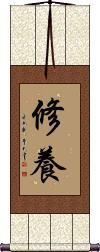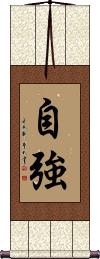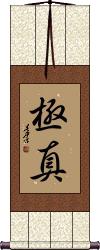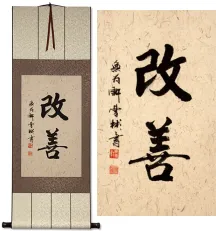Many custom options...
And formats...

Self-Improvement in Chinese / Japanese...
Buy a Self-Improvement calligraphy wall scroll here!
Personalize your custom “Self-Improvement” project by clicking the button next to your favorite “Self-Improvement” title below...
Self-Improvement
修養 means self-improvement in Chinese, Japanese Kanji, and old Korean Hanja.
Other translations for this word include accomplishment, training, self-cultivation, (mental) training, self-discipline, cultivation, or cultivating moral character.
Inner Strength / Self-Improvement
自強 is the kind of inner strength that applies to a person who has will-power and can inspire themselves to do great things.
自強 can also be the creed of a person that always pursues self-improvement.
Other translations: self-strengthening, striving for improvement, self-improvement, striving to become stronger, and self-renewal.
Kai Zen / Kaizen
改善 means betterment, improvement, to make better, or to improve - specifically incremental and continuous improvement.
改善 became very important in post-war Japan when Edwards Deming came to Japan to teach concepts of incremental and continuous improvement (for which the big 3 auto-makers did not want to hear about at the time - even kicking Deming out of their offices). The Japanese workforce absorbed this concept when their culture was in flux and primed for change.
This kaizen term is closely associated with the western title “Total Quality Management.” Perhaps dear to my heart since I spent years studying this at university before I moved to China where TQM did not seem to exist. Slowly, this concept has entered China as well (I've actually given lectures on the subject in Beijing).
If you are trying to improve processes at your business or need to remind yourself of your continuous TQM goals, this would be a great wall scroll to hang behind your desk or in your workplace.
See Also: Kansei
Always Striving for Inner Strength
自強不息 is a proverb or idiom that suggests that the pursuit of self-improvement is eternal. It can also be a suggestion to strive unremittingly in life.
The first two characters mean inner strength with the idea of self-improvement. The last two characters mean “never rest” or “striving without giving up.”
Some will translate these four characters as “Exert and strive hard without any let-up.”
Kyokushin
極真 is the Japanese title Kyokushin.
The literal meaning is “great truth” or “ultimate truth.” However, 極真 is usually associated with the style of stand-up, full-contact karate, founded in 1964 by Masutatsu Oyama (大山倍達).
Practitioners of the Kyokushinkai Karate follow a philosophy of discipline and self-improvement.
Therapeutic Massage
推拿 is “Tui Na,” a Chinese version of therapeutic massage.
The title suggests a pushing and pulling motion.
In reality, this is the most legitimate form of massage in China. Seeing this on a sign in front of a building tells you it's a place for health improvement via massage. No mistaking this for any illicit version of massage.
Resilience / Restoration / Recovery
恢復力 suggests having the power to recover, restore, and rehabilitate. This can refer to yourself, someone else, or even to something, like rehabilitating a burned forest. 恢復力 is the essence of resilience in life.
The first two characters are a word that means to reinstate, resume, restore, recover, regain, or rehabilitate, restoration, rehabilitation, recovery, return, improvement, recovery (from an illness), recuperation, or convalescence.
The last character means strength or power.
See Also: Tenacity | Perseverance
This in-stock artwork might be what you are looking for, and ships right away...
Gallery Price: $200.00
Your Price: $111.88
Not the results for self-improvement that you were looking for?
Below are some entries from our dictionary that may match your self-improvement search...
| Characters If shown, 2nd row is Simp. Chinese |
Pronunciation Romanization |
Simple Dictionary Definition |
修養 修养 see styles |
xiū yǎng xiu1 yang3 hsiu yang shuuyou / shuyo しゅうよう |
More info & calligraphy: Self-Improvement(n,vs,vi) self-improvement; (mental) training; self-discipline; cultivation cultivating moral character |
自強 自强 see styles |
zì qiáng zi4 qiang2 tzu ch`iang tzu chiang jikyou / jikyo じきょう |
More info & calligraphy: Inner Strength / Self-Improvement(noun/participle) strenuous effort |
自強不息 自强不息 see styles |
zì qiáng bù xī zi4 qiang2 bu4 xi1 tzu ch`iang pu hsi tzu chiang pu hsi |
More info & calligraphy: Always Striving for Inner Strength |
要好 see styles |
yào hǎo yao4 hao3 yao hao |
to be on good terms; to be close friends; striving for self-improvement |
上進心 上进心 see styles |
shàng jìn xīn shang4 jin4 xin1 shang chin hsin |
ambition; desire for self-improvement |
自利行 see styles |
zì lì xíng zi4 li4 xing2 tzu li hsing jiri no gyō |
to practice of self-improvement |
吳下阿蒙 吴下阿蒙 see styles |
wú xià ā méng wu2 xia4 a1 meng2 wu hsia a meng |
General Lü Meng 呂蒙|吕蒙 of the southern state of Wu (idiom); model of self-improvement by diligent study (from unlettered soldier to top strategist of Wu) |
聯合自強 联合自强 see styles |
lián hé zì qiáng lian2 he2 zi4 qiang2 lien ho tzu ch`iang lien ho tzu chiang |
to combine together for self-improvement; joint movement for self-strengthening |
自分磨き see styles |
jibunmigaki じぶんみがき |
self-improvement |
自利行滿 自利行满 see styles |
zì lì xíng mǎn zi4 li4 xing2 man3 tzu li hsing man jiri gyōman |
completion of practices for self-improvement |
自己研鑽 see styles |
jikokensan じこけんさん |
self-improvement |
自己鍛錬 see styles |
jikotanren じこたんれん |
self-discipline; self-improvement |
自強自立 自强自立 see styles |
zì qiáng zì lì zi4 qiang2 zi4 li4 tzu ch`iang tzu li tzu chiang tzu li |
to strive for self-improvement |
自己啓発本 see styles |
jikokeihatsubon / jikokehatsubon じこけいはつぼん |
self-improvement book |
The following table may be helpful for those studying Chinese or Japanese...
| Title | Characters | Romaji (Romanized Japanese) | Various forms of Romanized Chinese | |
| Self-Improvement | 修養 修养 | shuuyou / shuyo shuyo / shuyo | xiū yǎng / xiu1 yang3 / xiu yang / xiuyang | hsiu yang / hsiuyang |
| Inner Strength Self-Improvement | 自強 自强 | zì qiáng / zi4 qiang2 / zi qiang / ziqiang | tzu ch`iang / tzuchiang / tzu chiang | |
| Kai Zen Kaizen | 改善 | kai zen / kaizen | gǎi shàn / gai3 shan4 / gai shan / gaishan | kai shan / kaishan |
| Always Striving for Inner Strength | 自強不息 自强不息 | zì qiáng bú xī zi4 qiang2 bu2 xi1 zi qiang bu xi ziqiangbuxi | tzu ch`iang pu hsi tzuchiangpuhsi tzu chiang pu hsi |
|
| Kyokushin | 極真 | kyoku shin / kyokushin | ||
| Therapeutic Massage | 推拿 | tuī ná / tui1 na2 / tui na / tuina | t`ui na / tuina / tui na | |
| Resilience Restoration Recovery | 恢復力 恢复力 | huī fù lì hui1 fu4 li4 hui fu li huifuli | ||
| In some entries above you will see that characters have different versions above and below a line. In these cases, the characters above the line are Traditional Chinese, while the ones below are Simplified Chinese. | ||||
Successful Chinese Character and Japanese Kanji calligraphy searches within the last few hours...













